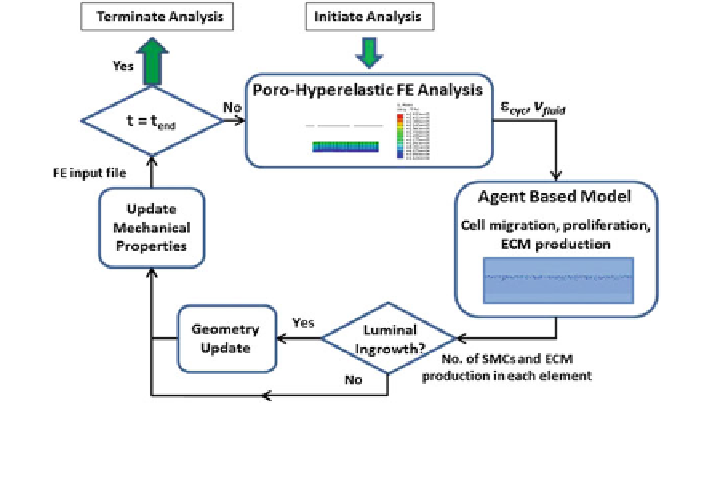Biomedical Engineering Reference
In-Depth Information
Fig. 5 Schematic of the mechanobiological modelling framework developed for simulation of
the mechanoregulation of growth and remodelling in tissue engineered blood vessels. (Image
courtesy of [
10
], with permission)
by altering the initial mechanical properties of the scaffold, i.e. stress-strain
response, permeability and porosity to that of the arterial tissue in elements where
the ECM content reached half of the collagen content in a native artery which is
approximately 3.1 9 10
-4
lg/cell [
53
].
Biological parameters such as the doubling time and the probability of apoptosis
were defined as mathematical functions of the cyclic strain and pore fluid velocity
for each VSMC. Increased cyclic strain decreased the doubling time of VSMCs and
increased their probability of apoptosis whilst low pore fluid velocity also
decreased the doubling time of VSMCs and increased the probability of apoptosis
given that at low interstitial fluid velocities exchange of nutrients and removal of
waste products within the scaffold would be impaired. On the other hand, collagen
synthesis by each VSMC was increased with increases in the amplitude of cyclic
strain.
Three main scenarios were then simulated using the developed mechanobio-
logical modelling framework, (see Fig.
6
); (i) VSMCs were seeded on an arterial
compliant scaffold and cultured under hypotensive (50-80 mmHg), normotensive
(80-120 mmHg) and hypertensive (140-200 mmHg) luminal pressure to investi-
gate the role of loading regime for both in-vivo and in-vitro applications,
(ii) VSMCs were seeded on an arterial compliant scaffold and cultured under a
pulsatile luminal pressure and luminal pore pressure of 80-120 mmHg with a
frequency of 1 Hz versus a non-pulsatile pressure of 100 mmHg, to study the
influence of pulsatile flow in in-vitro applications and (iii) VSMCs were seeded on
low compliance versus arterial compliant scaffolds and cultured under a pulsatile
luminal pressure of 80-120 mmHg with a frequency of 1 Hz to study the influence
of scaffold compliance for in-vivo and in-vitro applications.

Search WWH ::

Custom Search